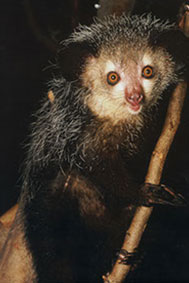Aye-aye
Daubentonia madagascariensis
Conservation status
Endangered (IUCN Red List, 2020)
Family
Daubentoniidae
What they look like
The aye-aye weighs about 2.5 kg (or 5.5 lbs) and is arguably the most distinct of all lemurs. They are a medium-sized, mostly black primate with very prominent, highly mobile ears and a long, bushy tail. They are also the only primate to have large, continuously-growing incisors, like a rodent. Most notably, however, are the aye-aye’s fingers. They have long, thin digits which are often described as skeletal in appearance, especially the third finger of the hand.
Where they live
The aye-aye may have the largest geographic range in Madagascar of any lemur. They are known from many sites throughout Madagascar’s remaining eastern rainforest, as well as further west in deciduous forests. They only seem to be absent from southwestern Madagascar. They are even known to reside on coconut plantations and in agricultural areas. Despite their wide distribution and ability to live in a variety of habitats, aye-aye sightings are rare, and they are seldom encountered.
What they eat
One of their primary food sources are the seeds of the ramy tree (Canarium spp.). Other favorite foods in the wild include seeds of Terminalia catappa and Orania trispatha, moth and beetle larvae inside trees and bamboo, and nectar from Ravenala madagascariensis. Their long skeletal middle finger allows aye-ayes to extract insect larvae which they locate by tapping bark and listening with their large, mobile ears. Once a grub is found, they gnaw through the wood and scoop the meal out with their long finger. Although aye-ayes are difficult to find in the wild, their presence can often be detected by examining tree trunks for holes where they have extracted grubs in the night. They have also been known to consume coconuts, mangos, and lychee fruits near villages.
How they behave
Active only during the night (nocturnal), aye-ayes were once thought to be solitary animals, but it now seems that they can occasionally be found together in groups of two or more. Individuals will spend the majority of the night moving and foraging for food. During the day, they sleep in tangles of branches and nests above ground. However, while active during the night, aye-ayes tend to spend more of their time moving around on the ground than any other species of lemur (with the exception of ring-tailed lemurs).
How they reproduce
Unlike other lemurs, aye-ayes do not seem to have a distinct breeding season but instead give birth throughout the year. They have one offspring every two to three years. In zoos, the average female reproductive cycle lasts 49.8 days and average gestation length is 164 days. Sperm plugs have been found in females who have recently copulated. Females in estrus emit loud vocalizations which attract multiple males that circle around the female, and agonistically interact for access. Females will mate with multiple males during a single estrus.
What threats they face
Human activity is causing extreme strain to the wild aye-aye population. Habitat loss and persecution as a crop pest are two major concerns. Unfortunately, in many areas of Madagascar aye-ayes are also deeply feared as harbingers of evil. The mere sight of an aye-aye is thought to foretell sickness and death in a village, and many locals believe the only way to lift the ill omen is to kill the aye-aye. Additionally, many trees that act as dietary staples for the species are being cut for construction purposes.
Aye-ayes in Marojejy National Park and Anjanaharibe-Sud Special Reserve
Little is known about the aye-aye populations in Marojejy and Anjanaharibe-Sud other than that they are present and have been recorded on surveys. Research is needed to help reveal their life history and population status within the reserve. Signs indicating their presence include holes gnawed in tree bark.
